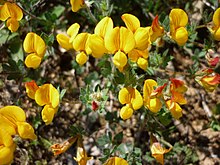Our website is made possible by displaying online advertisements to our visitors.
Please consider supporting us by disabling your ad blocker.
Lotus (genus)
| Lotus | |
|---|---|

| |
| Bird's-foot trefoil Lotus corniculatus | |
| Scientific classification | |
| Kingdom: | Plantae |
| Clade: | Tracheophytes |
| Clade: | Angiosperms |
| Clade: | Eudicots |
| Clade: | Rosids |
| Order: | Fabales |
| Family: | Fabaceae |
| Subfamily: | Faboideae |
| Clade: | Robinioids |
| Tribe: | Loteae |
| Genus: | Lotus L. |
| Type species | |
| Lotus corniculatus L.
| |
| Species | |
|
Between 70–150; see text | |
| Synonyms[1] | |
|
List
| |
Lotus, a latinization of Greek lōtos (λωτός),[2] is a genus of flowering plants that includes most bird's-foot trefoils (also known as bacon-and-eggs)[3] and deervetches.[4] Depending on the taxonomic authority, roughly between 70 and 150 species are accepted, all legumes; American species formerly placed in the genus have been transferred to other genera. Lotus species are found in the Eastern Hemisphere and adapted to a wide range of habitats.
The aquatic plant commonly known as the Indian or sacred lotus is Nelumbo nucifera, a species not closely related to Lotus.
Previous Page Next Page


